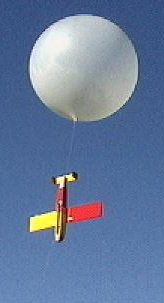 The Glidersonde
The Glidersonde
The Glidersonde is a small-unpowered autonomous sailplane that carries meteorological sensors for the collection of atmospheric data in a comparable method to a radiosonde. The Glidersonde has a wingspan of less than one meter and a total flying weight of approximately 2.0 kilograms. The Glidersonde contains a Global Positioning System (GPS) receiver and a small microcomputer used in determining relative position and navigation decisions.
The Glidersonde is carried aloft by a conventional gas-filled balloon measuring pressure, temperature, humidity and position data as it ascends. At a preset altitude, the Glidersonde releases itself from the balloon. The aircraft naturally flies to a level attitude and the autonomous navigation system steers it to the home or alternate location. After reaching the home location, the glider circles while descending. At a preset altitude above ground, a parachute deploys and the glidersonde is recovered. The vehicle can then be quickly refurbished and reused.
Data recovery can take one of two forms. The data can be stored internally in rewritable memory and downloaded after the vehicle is recovered or the data can be telemetered to a ground station as it is acquired. The data collection is equivalent in both accuracy and continuity to a standard radiosonde sounding. However, employing the Glidersonde vehicle, the meteorological sensor package is safely returned to be utilized over and again. The Glidersonde has the potential to augment many of the current radiosonde systems around the world, and would allow most countries to substantially increase both the frequency of soundings and the number of observing sites.

Schematic diagram of a compelte Glidersonde mission (not to scale)
Original Concept
The concept for a recoverable/reusable sonde was first proposed by Dean Lauritsen of the National Center for Atmospheric Research (NCAR). In Patent Number: 5,186,418 granted on February 16, 1993, Dr. Lauriten proposed developing a recoverable rawinsonde that would fly back to its launch point or suitable location with the vehicle guidance during descent utilizing a GPS based navigation control system.
Glidersonde Tidbits
The Glidersonde should not pose a hazard to general aviation since the design and construction materials follow Federal Aviation Administration regulations and guidelines (FAA REG. Sec 101).
The Glidersonde has the option of transmitting the meteorological and telemetry data stream in real time in addition to storing the information internal to the on-board memory. The data is downloaded from the Glidersonde after recovery.
The Glidersonde is configured to carry various other scientific payloads such as air chemistry or Ozone sondes. The meteorological and other sensors are located within the cargo bay beneath the Glidersonde wing. A payload bay is separate and insolated from the auto navigation system that controls and guides the aircraft.
The cargo bay has configurable openings to the outside and with the option of connecting to the GPS.
 Glidersonde
Details
Glidersonde
Details